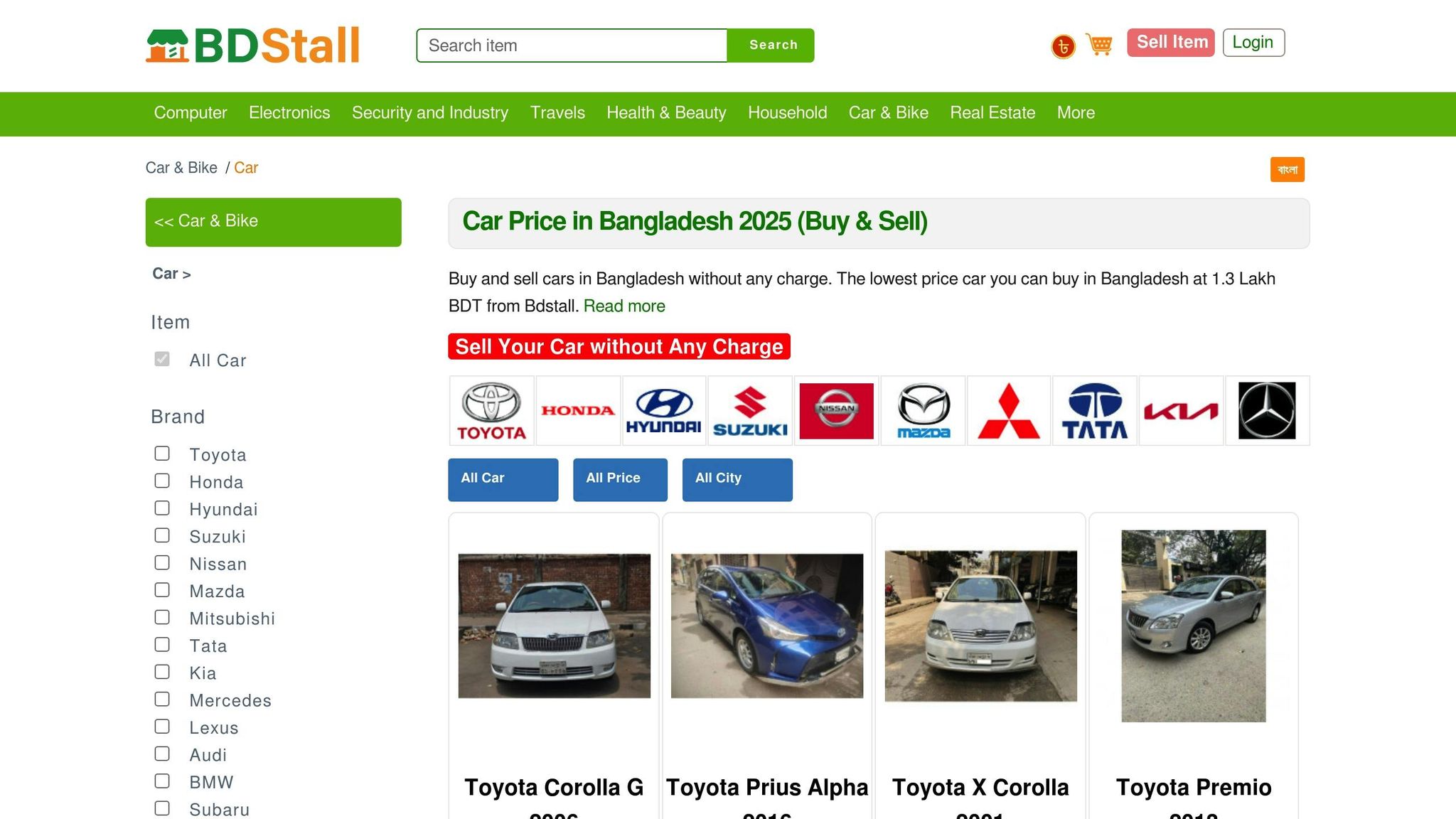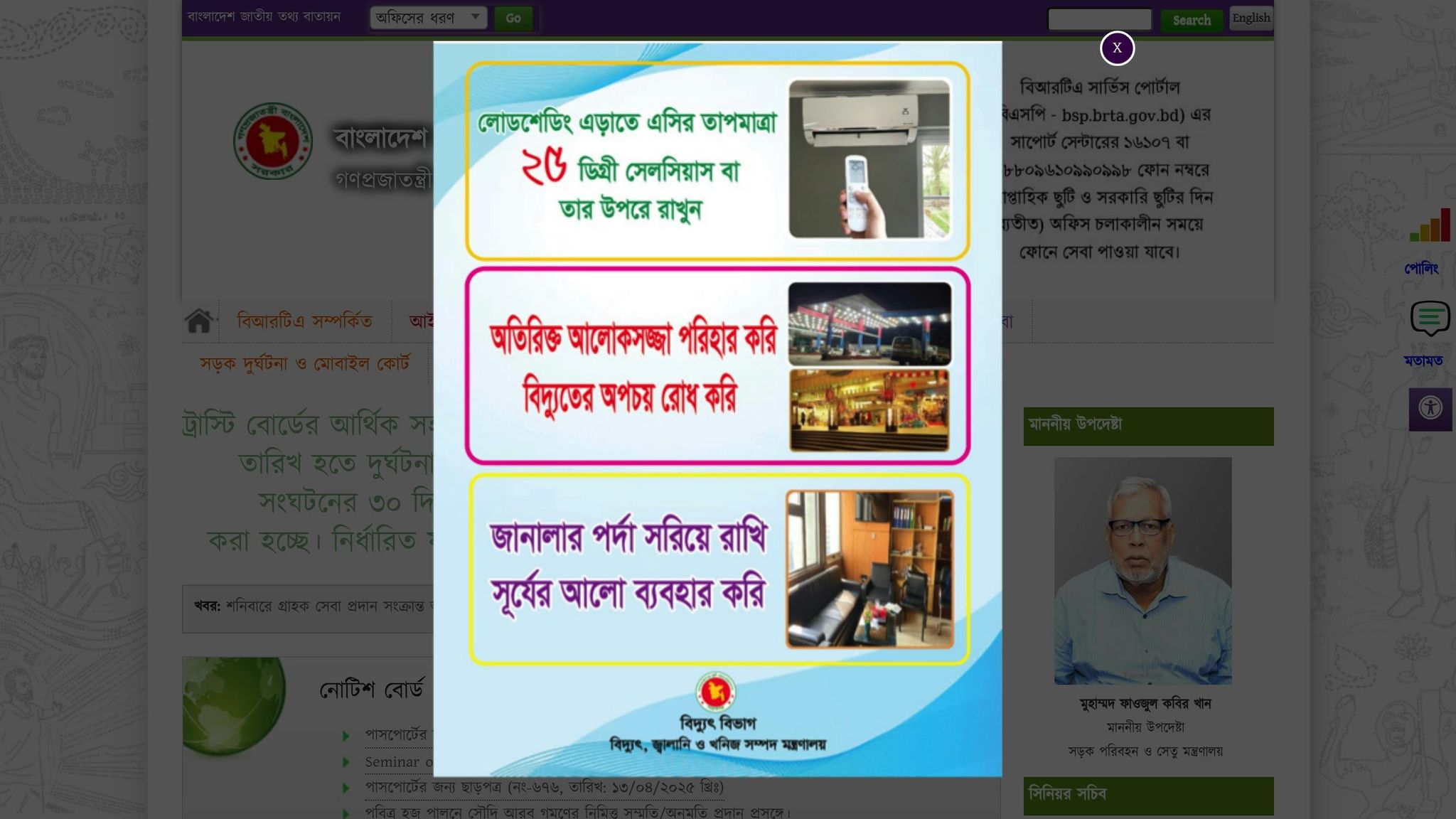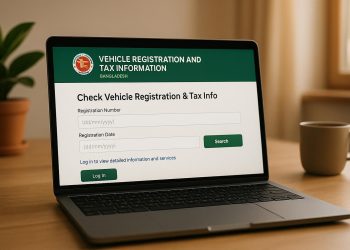Avoid expensive mistakes when buying a used car in Bangladesh by following this simple checklist:
- Verify Documents:
- Check the Registration Certificate (Blue Book) for matching engine/chassis numbers.
- Ensure the Tax Token and Fitness Certificate are valid and updated via BRTA‘s online portal.
- Confirm service records and previous ownership details.
- Inspect the Car:
- Exterior: Look for paint inconsistencies, rust, and structural damage.
- Interior: Check upholstery, electronics, AC, and dashboard.
- Engine: Test for oil leaks, fluid quality, and smooth cold starts.
- Assess Price:
- Compare market prices for similar models.
- Account for repairs, mileage, and ownership costs during negotiations.
- Transfer Ownership:
- Complete all BRTA paperwork, including forms, affidavits, and payment receipts.
- Ensure proper documentation for both buyer and seller.
- Post-Purchase Steps:
- Update registration, tax token, and insurance.
- Conduct a full mechanical assessment.
Pro Tip: Hire a trusted mechanic for a pre-purchase inspection (cost: Tk 6,000–Tk 12,000) to avoid hidden issues.
পুরাতন গাড়ি কিনতে কি কি বিষয় চেক করবেন | Used Car Buying Guide | BD4Wheels

Required Documents
Make sure to verify all documents thoroughly to avoid any legal troubles or ownership disputes.
Registration and Ownership Papers
Registration Certificate (Blue Book)
- Check that the owner’s details and the engine/chassis numbers match both the certificate and the vehicle itself.
Tax Token and Fitness Certificate
These can be verified online via the BRTA Service Portal (www.brta.gov.bd):
- Ensure the tax token confirms all dues are cleared.
- Verify the fitness certificate confirms the vehicle’s roadworthiness.
| Document Type | Key Verification Points | Validity Period |
|---|---|---|
| Registration Certificate | Engine & chassis numbers, owner details | Lifetime |
| Tax Token | Payment status, validity date | Annual |
| Fitness Certificate | Inspection date, renewal status | 1 year |
| Insurance Papers | Coverage period, policy type | Annual |
Maintenance and Repair History
Service Records
- Look for regular maintenance logs, records of major repairs, and routine services like oil changes.
Previous Ownership Records
- Verify details about previous owners, transfer dates, and check for any unexplained gaps in the records.
For a detailed review:
- Match service dates with the corresponding ownership periods.
- Look for any accident reports included in the service history.
- Confirm that any parts replacements or major repairs are properly documented.
Always ensure the authenticity of these documents before proceeding to inspect the car’s physical condition. Next, focus on evaluating the vehicle itself.
Physical Car Inspection
Once the documents are verified, the next step is a thorough physical inspection to assess the car’s actual condition.
Body and Paint Check
Examine the car’s exterior under clear daylight:
Paint Consistency
- Look for colour differences between panels, which may indicate past repairs.
- Check for paint bubbling near wheel wells and door frames.
- Observe panel reflections – waviness could point to repair work.
Structural Integrity
- Use a magnet to identify body filler and inspect panel gaps for consistency.
- Check wheel arches and door frames for signs of rust.
Interior Check
Pay close attention to these areas inside the car:
| Area | What to Check | Warning Signs |
|---|---|---|
| Seats | Upholstery condition | Tears, excessive wear, or stains |
| Dashboard | Controls and displays | Broken buttons or warning lights |
| AC System | Cooling performance | Weak airflow or unusual noises |
| Electronics | Power windows, central locking | Delayed response or strange sounds |
Engine and Parts Check
Pre-start Inspection
- Check levels of engine oil, coolant, and brake fluid.
- Inspect belts and hoses for any cracks or signs of wear.
- Look for oil leaks or coolant seepage around the engine.
Engine Operation
1. Cold Start Test
Observe the engine during a cold start. Watch for blue exhaust smoke, unusual noises like rattling or knocking, and ensure the engine idles smoothly.
2. Fluid Quality Check
Inspect these fluids for signs of issues:
- Engine oil: Should be clean, not black or gritty.
- Coolant: Should appear green or pink, not rusty.
- Transmission fluid: Should be red or pink, not brown.
A pre-purchase inspection by a qualified mechanic typically costs between Tk 6,000 and Tk 12,000. This small expense can save you from costly repairs later.
Professional Inspection
- Hire a trusted mechanic for a complete inspection.
- Request a detailed report from the mechanic.
- Test drive the car in different driving conditions to assess its performance.
Once you’re confident in the car’s mechanical condition, you can move on to evaluate its price and negotiate accordingly.
sbb-itb-a58e215
Price Evaluation and Bargaining
Market Price Analysis
Setting a fair price requires careful consideration of several factors. One key element is mileage, which often reflects the vehicle’s wear and tear. Alec Gutierrez, Director of Product Management at Cox Automotive Inc., explains:
"As mileage increases, so does wear and tear. Although condition is closely associated with mileage, the two are not directly correlated."
It’s also important to assess the overall condition and any modifications. Modified vehicles can be tricky. Philip Reed of NerdWallet advises:
"Buyers don’t know how well the work was done."
To determine a fair asking price, research similar models and compare their conditions, mileage, and any added features.
Dealer Negotiation Guide
Once you’ve set a price target, focus on negotiation strategies to ensure a fair deal.
- Get a vehicle history report: This helps uncover any past accidents or major repairs.
- Document inspection results: Use these findings to support your negotiation points.
- Research market prices: Compare the asking price with similar vehicles in the market.
- Account for ownership costs: Don’t forget to include BRTA fees and other expenses.
When negotiating, consider factors like:
- Minor repairs that may need attention
- Gaps in the service history
- Any recent reconditioning (ask for proof)
For added confidence, consult a trusted mechanic to verify repair costs and the vehicle’s value. This ensures you’re paying a price that aligns with the market.
Purchase Completion Steps
Ownership Transfer at BRTA

Proper documentation is key when transferring vehicle ownership through BRTA.
For Buyers:
- Filled-out ‘TO’ and ‘TTO’ forms
- Original registration certificate
- Payment receipts
- Certified TIN copy
- Non-judicial stamp affidavit (Tk.200 with photograph)
- Specimen signature form with three stamp-sized photos
- National ID
- Current utility bill
For Sellers:
- Signed ‘TTO’ form with sales receipt (including witness signatures and revenue stamp)
- Non-judicial stamp affidavit (Tk.200 with photograph)
- National ID copy
- Bank loan clearance certificate (if applicable)
For Company-Owned Vehicles: Add a board resolution, authorization letter, and an intimation letter on the company’s letterhead.
After completing the transfer, ensure all documents are accurate and move on to post-purchase steps to confirm your vehicle’s condition.
Post-Purchase Checks
Take care of these essential tasks:
- Documentation Management
Ensure you have and securely store digital copies of:- Updated registration certificate
- Tax token
- Insurance papers
- Ownership transfer documents
- Mechanical Assessment
Hire a certified mechanic to inspect:- Fluid levels and quality
- Brake system
- Transmission performance
- Electrical systems
- Administrative Updates
- Update your insurance policy
- Confirm tax token validity
- Check the fitness certificate
- Register for BRTA’s digital services
These steps will help you manage your new purchase effectively.
Wrapping It Up
Buying a used car in Bangladesh requires careful attention to detail. By checking everything thoroughly and following the right processes, you can avoid expensive mistakes and make a smart purchase.
Key Steps to Follow:
- Check all documents, inspect the car thoroughly, and get a professional mechanical assessment.
- Ensure the ownership transfer is completed correctly through BRTA.
- Keep all post-purchase paperwork organised and up to date.
For reconditioned cars, it’s crucial to review reconditioning details and auction sheet records to confirm their condition and authenticity.
Important Reminders:
With proper checks and paperwork, used cars can be a cost-effective choice. Always verify the car’s history, get a professional inspection, and handle all legal formalities to make an informed decision.
FAQs
What documents should I check before buying a second-hand car in Bangladesh?
When purchasing a second-hand car in Bangladesh, it’s crucial to verify the following key documents:
- Registration Certificate (Blue Book): Ensure the car is registered under the seller’s name and confirm the details match the vehicle.
- Tax Token: Check that the road tax has been paid and is up to date.
- Fitness Certificate: Verify the car has a valid fitness certificate, especially for older vehicles.
- Insurance Papers: Confirm the car’s insurance policy is valid and check the coverage details.
- Ownership Transfer Documents: Ensure you receive the necessary forms for transferring ownership, such as the BRTA-prescribed transfer form.
These documents are essential for a smooth and legal transaction. Always double-check their authenticity and ensure there are no discrepancies to avoid future complications.
What should I check to ensure a used car is in good mechanical condition before buying it?
To ensure a used car is in good mechanical condition, start by inspecting it during daylight on a flat surface. Look for any signs of uneven paint, rust, or dents, especially around joints and the underbody. Check for aftermarket modifications that may affect performance or safety.
Under the hood, examine the engine for leaks, unusual noises, or mismatched parts. Verify that fluid levels, such as engine oil, brake fluid, and coolant, are adequate and clean. If possible, take the car for a test drive to assess the engine performance, braking, and suspension. For added peace of mind, consider having a trusted mechanic inspect the vehicle before finalising your purchase.
What steps should I follow to transfer ownership of a used car through BRTA in Bangladesh?
To transfer ownership of a used car through BRTA in Bangladesh, you need to complete a few important steps. First, collect and fill out the TO and TTO forms. Submit these with the required documents, including:
- The original registration certificate
- A copy of your TIN certificate
- A recent affidavit with your photograph
- Three stamp-size colour photographs
If the buyer is an organisation, a signed official letter on the company’s letterhead is required instead of the affidavit. Additionally, you will need to pay the applicable fees and provide the payment receipt.
Finally, bring the vehicle to the BRTA office for inspection and biometric verification to complete the process. Ensuring all documents are accurate and complete will help you avoid delays or complications.
Related posts
- 10 Essential Tips for Buying a Toyota in Bangladesh
- Reasons and Solutions for a Car’s AC Not Cooling
- 5 Ways Fuel Costs Shape Used Car Prices
- Toll Roads Impact Air Quality in Bangladesh




